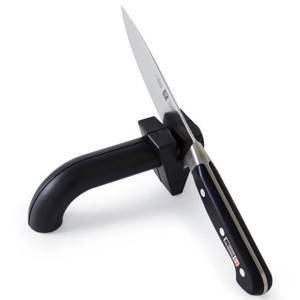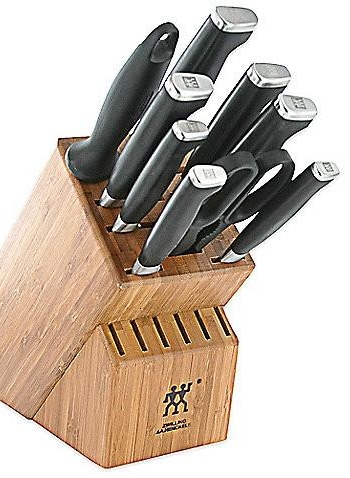Having a good set of basic cooking knives, as we explained in a previous post, is just half the battle. It’s just as important to care for them properly and to maintain their cutting edges with daily cleaning and sharpening rituals. Once you get in the habit, you’ll never suffer with a dull knife again!
You know what dull knives do. They squish Tomatoes, smush Sandwiches and mangle Meats. And they slip and slide all over the skins of fruits and veggies, possibly slicing into your fingers. Bad, bad, bad!
First, always clean your knives after a cooking session, but also during, whenever you switch from veggies to meat or vice-versa. This helps avoid cross contamination, the number one cause of food poisoning. to make it easier, clean your knife every time you wash your hands. And don’t forget to wash the handles of your knives, too! Those hands of yours are all over them!
Use warm water and liquid dish soap to clean your knives. No abrasives! And no steel wool, either! I’ve found that a plastic Molly Scrubber is ideal for cleaning my good knives. Either let your knives drip dry before returning them to the storage block, gently dry with a soft towel, making sure you keep your hands away from the blades.
Store Dry
Keep your knives dry. A good-quality knife block is ideal for this purpose. (Example pictured above.) Most have slots that go right through from top to bottom, allowing air circulation and letting any residual water from washing to drain off. When shopping for a knife block, always choose one with horizontal slots. Most cheap knife blocks have vertical slots which will dull and can even damage your fine blades. They let the edge of the blade sit on and rub against the wood! A good quality knife block will help preserve your knives and extend their life.
‘Sharpen’
Never sharpen your knives! This may sound crazy, but it’s got your attention while I explain the difference between sharpening and honing.
Sharpening means grinding off the old cutting edge so painstakingly and accurately put there at the factory and creating a new one. This usually isn’t necessary unless your knife has been damaged by dropping or using it on substances other than food. (No, no, no! Never do that!) And never use your good Chef knife as a Cleaver. That’s what Meat Cleavers and Chinese Choppers are for!
Honing is a relatively fine method of dressing or refining the edge of your blade. It only takes off a very little metal prolonging both the life of your edge and your knife. Old-time barbers used leather strops to hone their straight razors between shaves. Chefs today use metal or ceramic tools to hone their blades between every session. Sometimes, they hone during sessions, following every cleaning. Honing makes the cutting edge of your knife finer, removing burrs and fine nicks and scratches that result from normal use. This lets your knife cut like new again, every time.
The ‘Steel’ which probably came with your last cheap or mid-price knife kit is the traditional and primary Chef’s hone. It looks like a long, rat-tail file (round in cross section) and usually has a good sturdy handle with a hilt to keep you from cutting your hone-holding hand on the down strokes. The one you already have is probably not up to the challenge of properly maintaining your good knives. Spend a decent sum to get a hone/Steel that’s at least the equal in quality of your good knives.
There are lots of video tutorials on the Net to show you how to hone. It’s a skill that will make all your cooking chores more pleasurable!
Take the time to do it right…
Clean, store and maintain your good knives properly and you’ll have a set of tools to pass on to the next generation. And, yes, the kids will fight over them, because you’ve kept them so pristine and you made so many memorable meals with them!
~ Maggie J.


